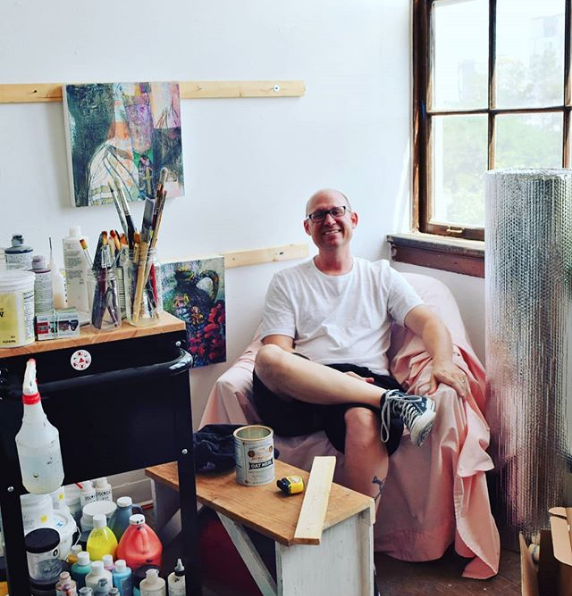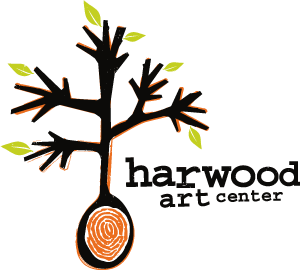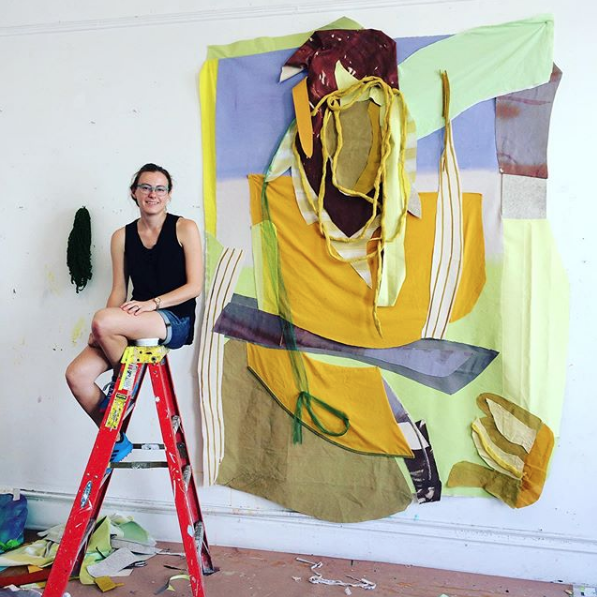Our January 2020 exhibiting artists, Andrew Fearnside and Molly Zimmer, did a question and answer exhange ahead of their solo exhibitions. They graciously shared their words with us, giving deeper insight into their creative practice.

Andrew Fearnside
What types of patterns are you interested in and why? What about the cactus shape?
AF: I love what I’ve learned about prickly pears and cholla. I love them through a heart informed by what I’ve observed about their way of living, their anatomy, their way of living together. And at the same time, prickly pears are so subtle… their shapes are easily overlaid with projections from within us. A nopale is a balloon, a paddle, a hand, a face, a cookie… etc. It’s so hard to see what the plant is actually doing, actually being. And I would like to get to know it.
Are you a collector or gatherer, what do you see your relationship to objects you surround yourself with?
AF: I collect materials. I’m always playing with a minor obsession about a process, a system I’m fascinated with. I love scrounging for cardboard, wood, paint, and junk, because I love the process of seeing new things in old objects. Over the years I learn about the supply chain the cardboard accompanies. Like a lot of us on the left, I fell in love with permaculture in the 90s and 00s. I realized that waste streams are like creeks in the Gold Rush. Like my printmaker mother, I’ve always looked to trash for the basic nutrients of my workshop processes.
I’m not much of a collector of physical objects, because I need clarity and simplicity at home too much to nurse a collection of mugs, let alone paintings. I tend to give my own stuff away after a while, or toss it.
I am a collector of poetry, however. Well, poetry as I see it. Moments in films, in songs, in ads and magazine designs and runway displays. Moments of coherence on a walk, in conversation, in dreams. In the 90s I collected fonts on dozens of floppies… Photocopies of images from art libraries… videotapes of fragments of dances by myself and friends. Today I use Pinterest to collect and archive thousands of images of every kind of visual poetry I can find. Only a tiny percentage are “mine.”
What is your frontier in your art practice?
AF: For a long time now I’ve been sketching from film stills, the European Christian tradition, the tarot, and comics. From Rashomon; from Reubens; from Grease and the Marseilles deck. How do these works tell stories? How does one tell a story when you’ve got just one image, albeit a huge one, in which to do it? This is a mysterious landscape for me, in part because there are so many ways artists have done it, and in part because it’s about finding the places within it that are alive for me—about restoring my voice.
There’s something about the way the Brazilian duo Bicicleta Sem Freio collides stories together that I want to sketch, dissect, understand.
How would you describe your inner critic?
AF: I’ve come to realize that I need my inner critic, even it’s uncomfortable at the best of times, and possessive at the worst. It works like a gland, like an organ of consciousness. The instant it contacts something it finds dangerous, it immerses my thoughts in acid. It feels like the opposite of life. But after its raw waters have receded, I often realize that it was reacting to something that I needed to pay attention to. This viper is only aroused when I’ve been clumsy with my boundaries, or ignorant of my limits. Medicine is often bitter, you know?
Do you see yourself as a storyteller? Interested in folklore or ways of describing spiritual navigation?
AF: I think I’m a storyteller, but a weird one: more like a story-suggester. I am fascinated by character. In portraits, I’m shooting for a picture that embodies a a living sense of a person… a “character” I’ve perceived within that person. I have no illusions that I’ve captured an essence, because that’s impossible. But I do hope to quicken something real in my picture.
SPIRITUAL NAVIGATION, ARTIST’S ROLE
This is the perennial path for me, the bunny trail that calls me into the wilderness over and over. I love that phrase! Thank you.
IMO there is nothing more important than spiritual navigation. As embodied beings, our lives are so tiny, our consciousness so frail that we can’t hope to set boundaries around the big things that carry us along. “The life so short, the craft so hard to learn,” as bawdy Mr. Chaucer said. I believe that creative inspiration is the most powerful force in our world, for it is that substance, the juice behind a successful piece of poetry, that anyone can imbibe and be changed by. That being said, being an artist is like being a frog in a swamp—we are absolutely porous, completely open to the effluent in the marsh water, as it were. If there’s something in our shared cultural waters that’s going to alter our genomes, the artists will get it first. We’ll be flopping around with two heads or two arms long before anyone else. So as artists we are very powerful, though not in a way we can intend to be; and we are very vulnerable, also not in a way we can intend to be. I believe that’s our role—to BE something necessary, not to ACT with great power. That’s for the politicians to deal with.
Light seems important in your work– how do you think about daylight, fluorescent light, vs black light?
AF: In high school, Lucas Samaras’ hyper-lit Polaroids of himself and his friends inspired the shit out of me. Still does, to be honest. And then stills from a late Fassbinder film about gay sailors, also hyper-lit, got me as well. Light as a source of wildly saturated color, overpowering naturalism, overpowering social norms. Light as a demand that we enter a fictional space together. I started putting periods together when I encountered Caravaggio, and even darker, the Spanish painter de Ribera. Light as divine consciousness, of course.
We encounter poetry with a squawking menagerie of stories swirling through us. There’s something about seducing those creatures with bright, candied light that is both beautiful and necessary, if we’re going to find the doors in the work. I believe in having our cake and eating it too, because as Lennon said, “… carrying pictures of Chairman Mao/ You ain’t gonna make it with anyone anyhow.” It’s like 3D glasses, in a way.
What aspect of the immigration issue do you want to discuss/help others understand? Does this draw on your personal history?
AF: Art has always been a way to understand things, for me. And in this work, the Electric Desert, I think I understood that I have little to say about immigration that is coming from my own heart. I am still devastated by what happened to Macho B. I’m still devastated by the loss and death that immigrants crossing our Southwestern borders have experienced. But this piece presents with the kind of simple joy kids understand, and the darkness suggested by the black light hides in the core of its big cardboard tubes. And that’s good, I feel. I’m still not sure that turning that inside out—hiding the joy on the inside, and roaring around with the darkness on the outside—would make for either good art, or good learning.
Molly Zimmer
How do you imagine the relationship between your work and the environments it finds itself? Have you experimented within that relationship? What happens within that artwork+context relationship when your works leave the studio?
MZ: I think that I am still navigating and working on building my environments for my pieces. I think the multiplicity of work in a space creates its own environment, changing the atmosphere of a room — the literal and palpable feel of a space that is inhabited by my thoughts and emotions conveyed in color and pattern.
Your work draws on the making vocabularies and histories of sewing and pattern making; surface design and textile design; and all kinds of painting. What’s a making vocabulary a newcomer to your work would be surprised to find that you love? What’s a making language that fascinates you now, but that isn’t obvious within your work? Are there making vocabularies that resist your interest, that seem to confound your attempts to engage with them?
MZ: Typical making vocabularies– painting, oil bars, weaving, knitting, quilting, drawing, abstraction, clothing design, screenprinting, digital sketches, collecting color palettes, knotting, hat-making, basket-making, costume/camouflage.
Right now, a newer one is making woven baskets out of felt. I am also spinning yarn, dying yarn with collected cosmos flowers, and creating a more traditional quilt of my own design. Knitting socks. Another is making hand-made cards for people. I have also started making small collages during live model sessions at the harwood— I bring scraps, glue and my scissors, and work during the 5, 10, 20 minute sessions. That is exhilarating to try and capture it with a small amount of time, really gets things flowing! I think that with gardens, and nature, it is always in respect to our bodies interacting with shapes, so to me collage is an appropriate medium.
How would you describe your relationship with the French post-structuralist theory of the 60s and 70s, American feminist theory of the 70s and 80s, the gender theory of the 90s? Are you interested in political readings of your work? If so, how would you characterize your relationship to the theories that undergird our moment in Progressive struggle?
MZ: I think the struggle is really about keep on keeping on — making the work, expression, being true to yourself– and that is something of the moment today, it is expressing yourself and acknowledging the histories that have influenced you and that you are drawing on intentionally. Such as me working on Navajo Textiles, and having that affect my work subconsciously, and intentionally researching to learn more about Diné culture. I am not making a political statement about my work, and I think that ambiguity helps to keep work out of the cannon. I am also not a “woman artist”, I am an “artist”. I will leave the theory and politics to the art critics to discuss. I create art, critics dissect and break down art. I would say that my work does give a nod to the collective experiences of craft, women making household crafts, mending and fixing things — Dust Bowl Days of my family, and the idea of labor in work/process, labor of women— attached to that of quilting, weaving, knitting, crochet, embroidery, and other works to show skill/design. I can say that from a family of strong women, I am proud that my mom and grandmother taught me to sew and passed on a love for making things with my hands, being creative, self-sufficient and resourceful.
Are you a religious person? A spiritual person? Neither? Something else? How would start talking about your metaphysics, your sense of what is “real?” Are spirits real? Do trees have consciousness? How about bacteria? How about electrons, or quarks? Planets, or solar systems?
MZ: Religious — no, but making art takes a kind of “faith”. Spiritual–no, but I think there are rivers of consciousness that we as artists dip into and collectively explore. Spiritual in the sense that positivity and the power of thoughts can lead us in a direction, and that intuition is a strong internal navigator. Things are all interconnected, tied by strings of thought and energy — responding and pulling in many directions.
What are some pattern languages that you just can’t get enough of?
MZ: Lines, wiggly lines, straight lines, curved lines, rounded, jagged, and anything in between. I use drawn lines in my work to show textures of leaves and veins, or to convey my own sense of movement. Lines can show rows, lattices, perspective of agriculture and pathways. They are a mapping of space, a thought of mapping, internal dialogue, a diagram aspect. They convey structure and form, also structures of fabric, theads, looms and weaving warp threads. They can be veil, mesh, window, a brick walkway.
For our fellow artists—could you refer us to a text (book, video, poem, visual work, etc etc) that is an endlessly giving source of inspiration for you?
MZ: Really encouraging book on all the common artist doubts– to train your inner critic…. with lots of solitude in studio time, I need some good thoughts.
“Great artists are often childlike — it is a paradox of the creative life that serious art involves serious play — such as a kitten learning to hunt with a ball of yarn.” ~ from Letters to a Young Artist by Julia Cameron
A visual source would be ever-changing, but Shara Hughes is a current favorite painter, she uses typical kid crayons and materials in her drawings. Marsden hartley with such nice clouds and tree forms. Gee’s bend quilts. I like work that is unassuming and considered that there is no hierarchy inherent to shape or material used.
How would you describe your relationship to fluorescent colors?
MZ: Flourescents work like odd elements in textile design, similar to how they work in painting. Happenstance of colors. They seem to radiate light, other colors reflect light. Sunsets radiate, gardens reflect.
Could you share with us an artwork whose study really changed the way you think of “nature” and “the landscape?”
MZ: Charles Burchfield– love those wild trees and another similar– Henri Rousseau. They both capture a strangeness and beautifulness of the landscape that is more than what you can “see”, but also what you might “feel”.
If you were given a fully-funded artists’ retreat anywhere in the world (or the universe), where would you go, and what would you be excited to explore there?
MZ: Ah, so many places….. A natural space, just drop me off with my paints, some food and lots of coffee and let me get to painting. I especially enjoy mediteraniean and tropical climates with the types of plants that grow there. Bright colors, large sculptural foliage.
What’s more difficult for you as an artist—time management, accounting, or marketing? Where do you go to work on that difficult aspect of professional life?
MZ: These are all challenges as a younger artist, as most artists might not hit their stride until 65+, but I would say that for me writing/marketing is a challenging professional artist tool. I have a few trusted friends to edit and look over press/promotion/marketing, and with practice and creating a bank of language for your work, those tasks get easier.
Can you recommend a “channel” you tune in to to discover opportunities for your work?
MZ: Does “tending to a garden” count? I think being still enough to watch the seasons is an important and valuable way to discover/play/connect.

